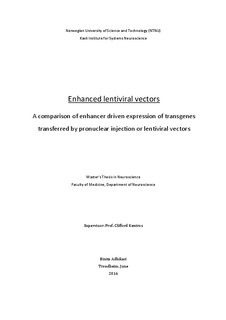Enhanced lentiviral vectors : a comparison of enhancer driven expression of transgenes transferred by pronuclear injection or lentiviral vectors
Master thesis
Permanent lenke
http://hdl.handle.net/11250/2437173Utgivelsesdato
2016Metadata
Vis full innførselSamlinger
Sammendrag
The brain is a vast network of different types of neurons. Interactions between these different types of neurons underlie the different kinds of neural computations the brain performs. How the different types of neurons are connected and interact is largely unexplored. However, transgenic mice allow for investigation of individual cell types in this heterogeneous network. By expressing fluorescent proteins in transgenic mice, the morphology of individual cell types can be visualized. Furthermore modified rabies viruses allow for the identification of monosynaptic inputs of specific cell types. Finally, novel techniques such as optogenetics and pharmacogenetics give control over the activity of genetically labeled neurons. In short, novel transgenic methods allow for the exploration of the brain and behavior on a cellular level.
However, these transgenic methods stand or fall by having genetic access to specific cell types. Current transgenic lines do not provide us with the specificity to get enough resolution. To increase resolution, we are using regulatory elements in the genome called enhancers to drive transgenes in specific brain regions. Transgenic lines created with enhancers have regional and cell type specificity. An alternative method to introduce the transgene to the brain is by viral vectors. In this thesis we investigate if enhancers transferred by lentiviral vectors may also show cell type specificity. The aim of this project is to compare the enhancer driven transgene expression in mice injected with lentivirus and in transgenic mice having same enhancer.
To achieve this aim, 3 enhancers which drive expression in the medial entorhinal cortex (MEC) of transgenic mice were cloned into plasmids that allow for the production of lentiviral vectors. The lentiviral vectors were stereotactically injected to the MEC of adult mice. We investigated the expression of the virally transduced transgene in comparison to the transgene expression in the transgenic mice. We did this based on anatomical location of the expression and co-expression of molecular markers.
We confirmed that in the transgenic mouse lines expression was confined to specific layers of the MEC. In contrast, in virus injected mice, the transgenes were expressed throughout layers. This suggests that enhancers did not have any specificity after gene transfer by lentiviral vectors. The molecular marker we investigated, calbindin, is not expressed in the transgene expressing cells of the transgenic lines. Neither did we find it in the cells that were transduced with the transgene by injection of viral vector. Though this may indicate specificity of the transgenic expression after transfection with the viral vector, it should be taken with care considering the unexpected staining for calbindin in the virus injected mice.
